The Earth has always been bombarded with rocks from space. It’s true to say though that there were more rocks flying around the Solar System during earlier periods of its history. A team of researchers have been studying a meteorite impact from 3.26 billion years ago. They have calculated this rock was 200 times bigger than the one that wiped out the dinosaurs. The event would have triggered tsunamis mixing up the oceans and flushing debris from the land. The newly available organic material allowed organisms to thrive.
Continue reading “A Giant Meteorite Impact 3.26 Billion Years Ago Helped Push Life Forward”Best Image Ever Taken of Stars Buzzing Around the Milky Way’s Supermassive Black Hole
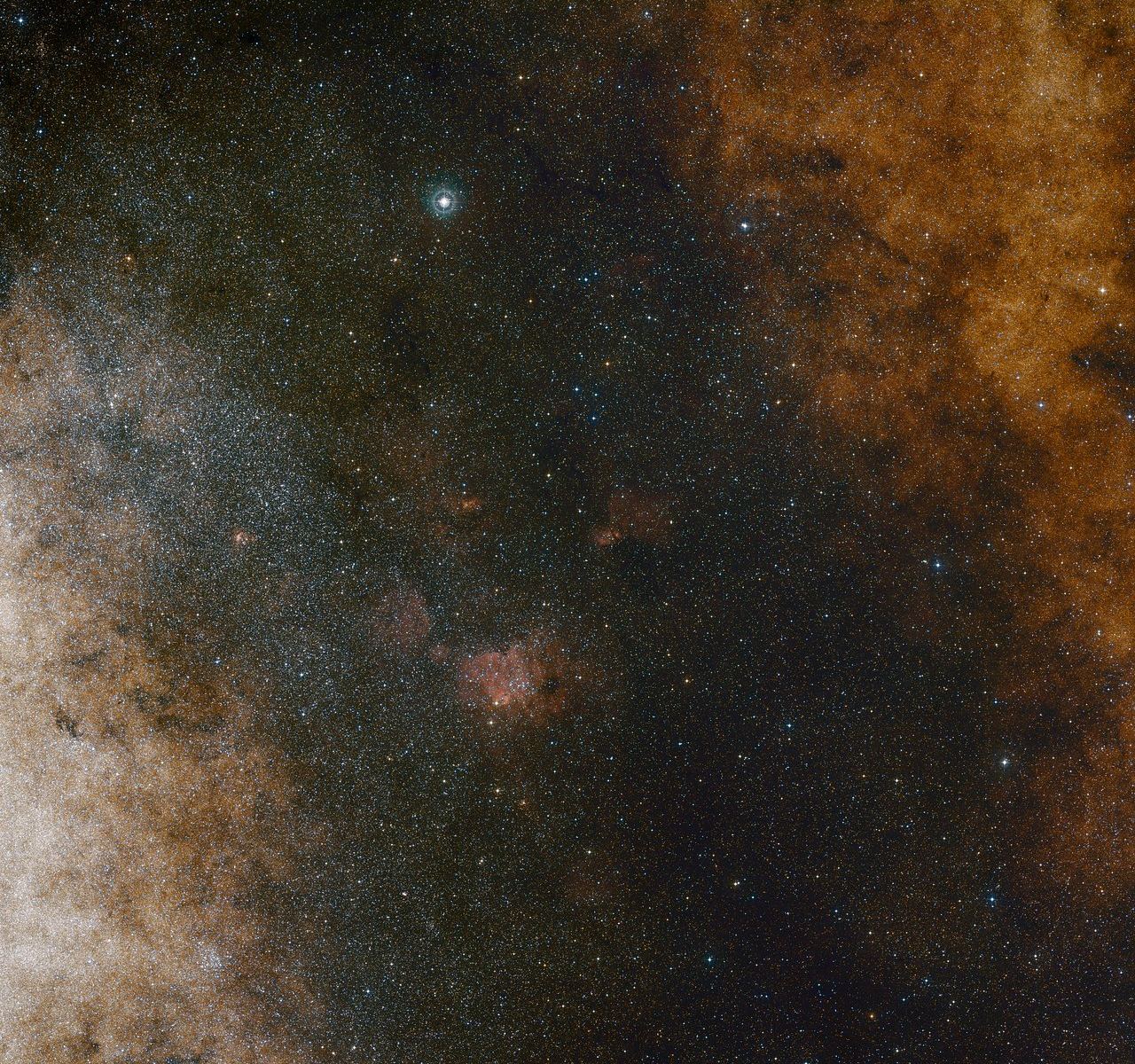
It all began with the discovery of Sagittarius A*, a persistent radio source located at the Galactic Center of the Milky Way that turned out to be a supermassive black hole (SMBH). This discovery was accompanied by the realization that SMBHs exist at the heart of most galaxies, which account for their energetic nature and the hypervelocity jets extending from their center. Since then, scientists have been trying to get a better look at Sag A* and its surroundings to learn more about the role SMBHs play in the formation and evolution of our galaxy.
This has been the goal of the GRAVITY collaboration, an international team of astronomers and astrophysicists that have been studying the core of the Milky Way for the past thirty years. Using the ESO’s Very Large Telescope Interferometer (VLTI), this team obtained the deepest and sharpest images to date of the region around Sag A*. These observations led to the most precise measurement yet of the black hole’s mass and revealed a never-before-seen star that orbits close to it.
Continue reading “Best Image Ever Taken of Stars Buzzing Around the Milky Way’s Supermassive Black Hole”One Star Could Answer Many Unsolved Questions About Black Holes

A supermassive black hole (SMBH) likely resides at the center of the Milky Way, and in the centers of other galaxies like it. It’s never been seen though. It was discovered by watching a cluster of stars near the galactic center, called S stars.
S stars’ motions indicated the presence of a massive object in the Milky Way’s center and the scientific community mostly agreed that it must be an SMBH. It’s named Sagittarius A*.
But some scientists wonder if it really is a black hole. And one of the S stars could answer that question and a few others about black holes.
Continue reading “One Star Could Answer Many Unsolved Questions About Black Holes”A Star is Orbiting the Milky Way’s Black Hole and Moving Exactly How Einstein Predicted it Should
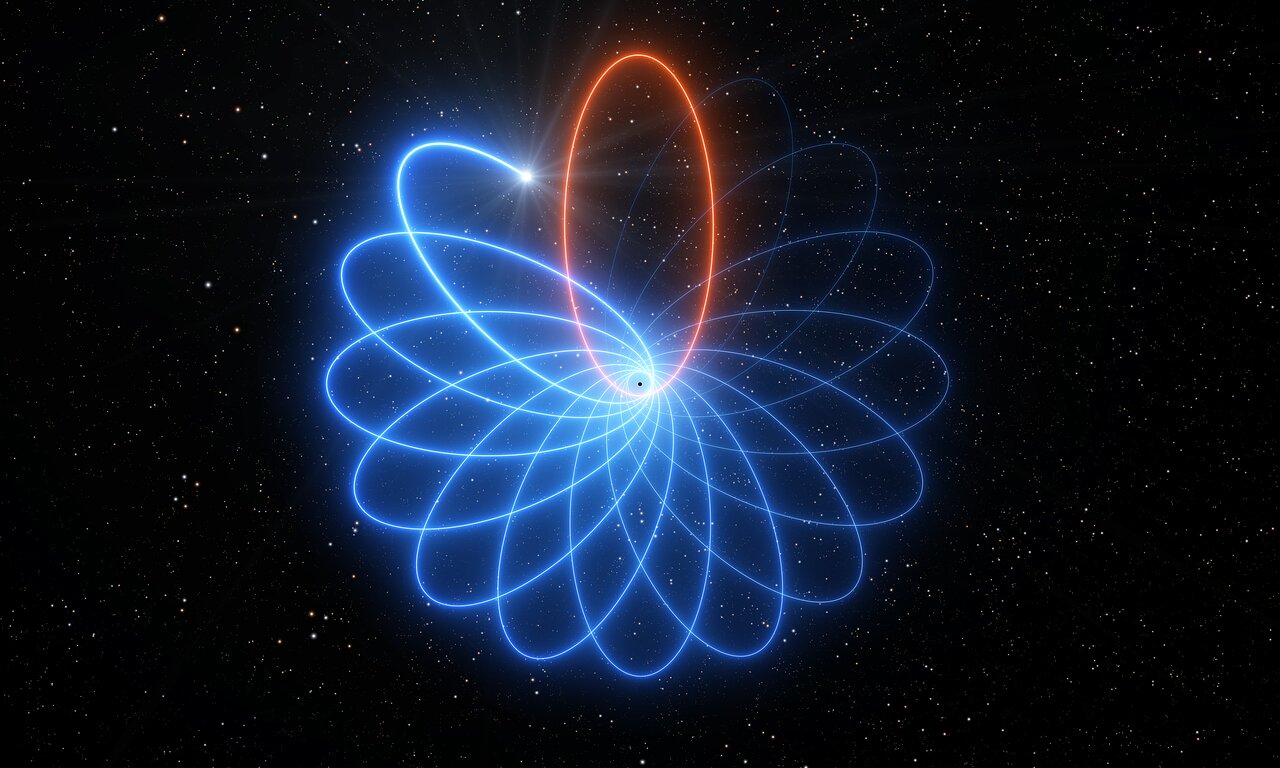
At the center of our galaxy, roughly 26,000 light-years from Earth, is the Supermassive Black Hole (SMBH) known as Sagittarius A*. The powerful gravity of this object and the dense cluster of stars around it provide astronomers with a unique environment for testing physics under the most extreme conditions. In particular, it offers them a chance to test Einstein’s Theory of General Relativity (GR).
For example, in the past thirty years, astronomers have been observing a star in the vicinity of Sagittarius A* (S2) to see if its orbit conforms to what is predicted by General Relativity. Recent observations made with the ESO’s Very Large Telescope (VLT) have completed an observation campaign that confirmed that the star’s orbit is rosette-shaped, once again proving that Einstein theory was right on the money!
Continue reading “A Star is Orbiting the Milky Way’s Black Hole and Moving Exactly How Einstein Predicted it Should”Stars Orbiting Supermassive Black Hole Show Einstein was Right Again!
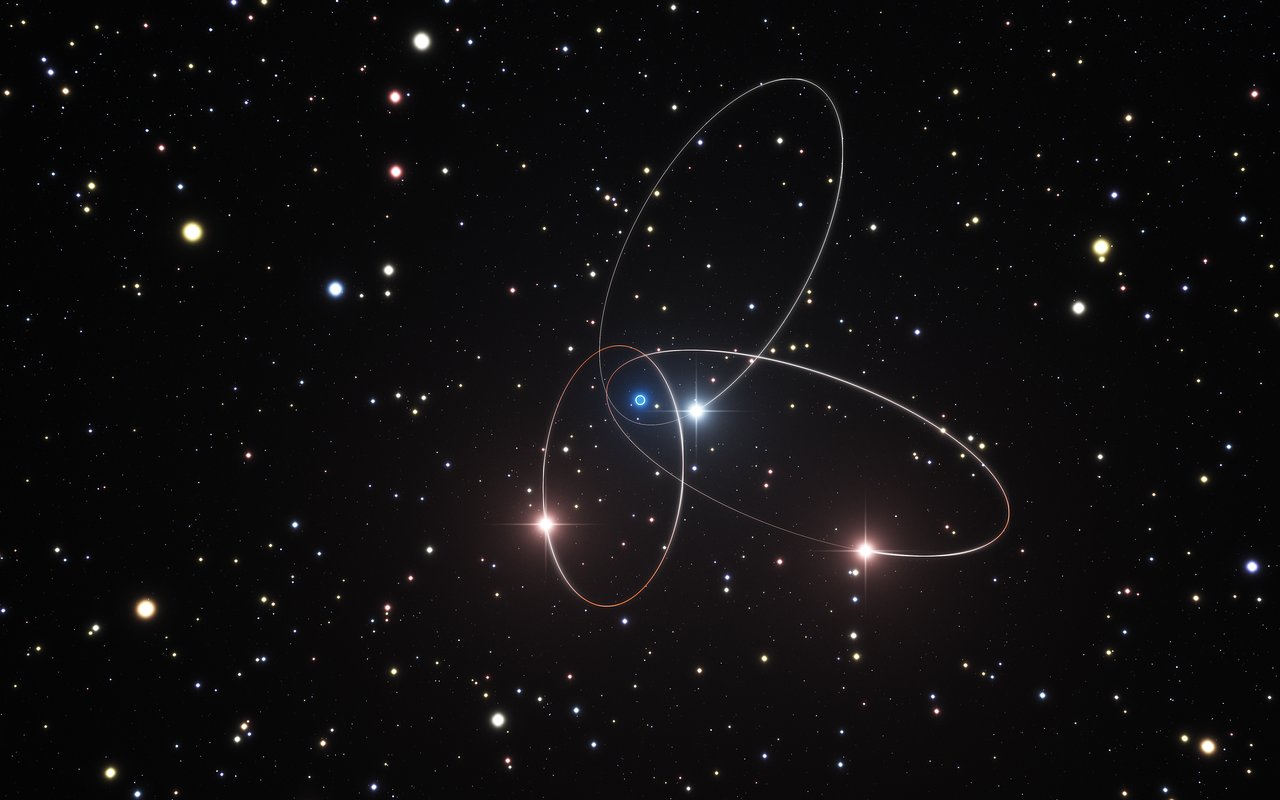
At the center of our galaxy, roughly 26,000 light years from Earth, lies the Supermassive Black Hole (SMBH) known as Sagittarius A*. Measuring 44 million km across, this object is roughly 4 million times as massive as our Sun and exerts a tremendous gravitational pull. Since astronomers cannot detect black holes directly, its existence has been determined largely from the effect it has on the small group of stars orbiting it.
In this respect, scientists have found that observing Sagittarius A* is an effective way of testing the physics of gravity. For instance, in the course of observing these stars, a team of German and Czech astronomers noted subtle effects caused by the black hole’s gravity. In so doing, they were able to yet again confirm some of the predictions made by Einstein’s famous Theory of General Relativity.
Their study, titled “Investigating the Relativistic Motion of the Stars Near the Supermassive Black Hole in the Galactic Center“, was recently published in the Astrophysical Journal. As is indicated in the course of it, the team applied new analysis techniques to existing observations that were made by European Southern Observatory’s (ESO) Very Large Telescope (VLT) and other telescopes over the course of the past 20 years.
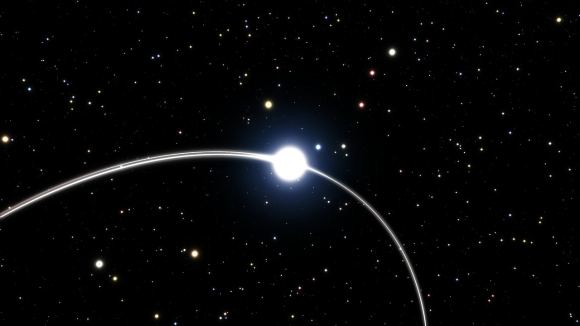
From this, they measured the orbits of the stars that orbit Sagittarius A* to test predictions made by classical Newtonian physics (i.e. Universal Gravitation), as well as predictions based on general relativity. What they found was that one of the stars (S2) showed deviations in its orbit which were defied the former, but were consistent with the latter.
This star, which has 15 times the mass of our Sun, follows an elliptical orbit around the SMBH, completing a single orbit in about 15.6 years. At its closest, it gets to within 17 light hours of the black hole, which is the equivalent of 120 times the distance between the Sun and the Earth (120 AU). Essentially, the research team noted that S2 had the most elliptical orbit of any star orbiting the Supermassive Black Hole.
They also noted a slight change in its orbit – a few percent in the shape and about one-sixth of a degree in orientation. This could only be explained as being due to the relativistic effects caused by Sagittarius A* intense gravity, which cause a precession in its orbit. What this means is, the elliptical loop of S2’s orbit rotates around the SMBH over time, with its perihelion point aimed in different directions.
Interestingly enough, this is similar to the effect that was observed in Mercury’s orbit – aka. the “perihelion precession of Mercury” – during the late 19th century. This observation challenged classical Newtonian mechanics and led scientists to conclude that Newton’s theory of gravity was incomplete. It is also what prompted Einstein to develop his theory of General Relativity, which offered a satisfactory explanation for the issue.
Should the results of their study be confirmed, this will be the first time that the effects of general relativity have been precisely calculated using the stars that orbit a Supermassive Black Hole. Marzieh Parsa – a PhD student at the University of Cologne, Germany and lead author of the paper – was understandably excited with these results. As she stated in an ESO press statement:
“The Galactic Center really is the best laboratory to study the motion of stars in a relativistic environment. I was amazed how well we could apply the methods we developed with simulated stars to the high-precision data for the innermost high-velocity stars close to the supermassive black hole.“
This study was made possible thanks to the high-accuracy of the VLT’s instruments; in particular, the adaptive optics on the NACO camera and the SINFONI near-infrared spectrometer. These instruments were vital in tracking the star’s close approach and retreat from the black hole, which allowed for the team to precisely determine the shape of its orbit and thusly determine the relativistic effects on the star.
In addition to the more precise information about S2’s orbit, the team’s analysis also provided new and more accurate estimates of Sagittarius A* mass, as well as its distance from Earth. This could open up new avenues of research for this and other Supermassive Black Holes, as well as additional experiments that could help scientists to learn more about the physics of gravity.

The results also provided a preview of the measurements and tests that will be taking place next year. In 2018, the star S2 will be making a very close approach to Sagittarius A*. Scientists from around the world will be using this opportunity to test the GRAVITY instrument, a second-generation instrument that was recently installed on the Very Large Telescope Interferometer (VLTI).
Developed by an international consortium led by the Max Planck Institute for Extraterrestrial Physics, this instrument has been conducting observations of the Galactic Center since 2016. In 2018, it will be used to measure the orbit of S2 with even greater precision, which is expected to be most revealing. At this time, astrophysicists will be seeking to make additional measurements of the SMBH’s general relativistic effects.
Beyond that, they also hope to detect additional deviations in the star’s orbit that could hint at the existence of new physics! With the right tools trained on the right place, and at the right time, scientists just might find that even Einstein’s theories of gravity were not entirely complete. But in the meantime, it looks like the late and great theoretical physicist was right again!
And be sure to check out this video of the recent study, courtesy of the ESO:
Further Reading: ESO, Astrophysical Journal
A Star Is About To Go 2.5% The Speed Of Light Past A Black Hole
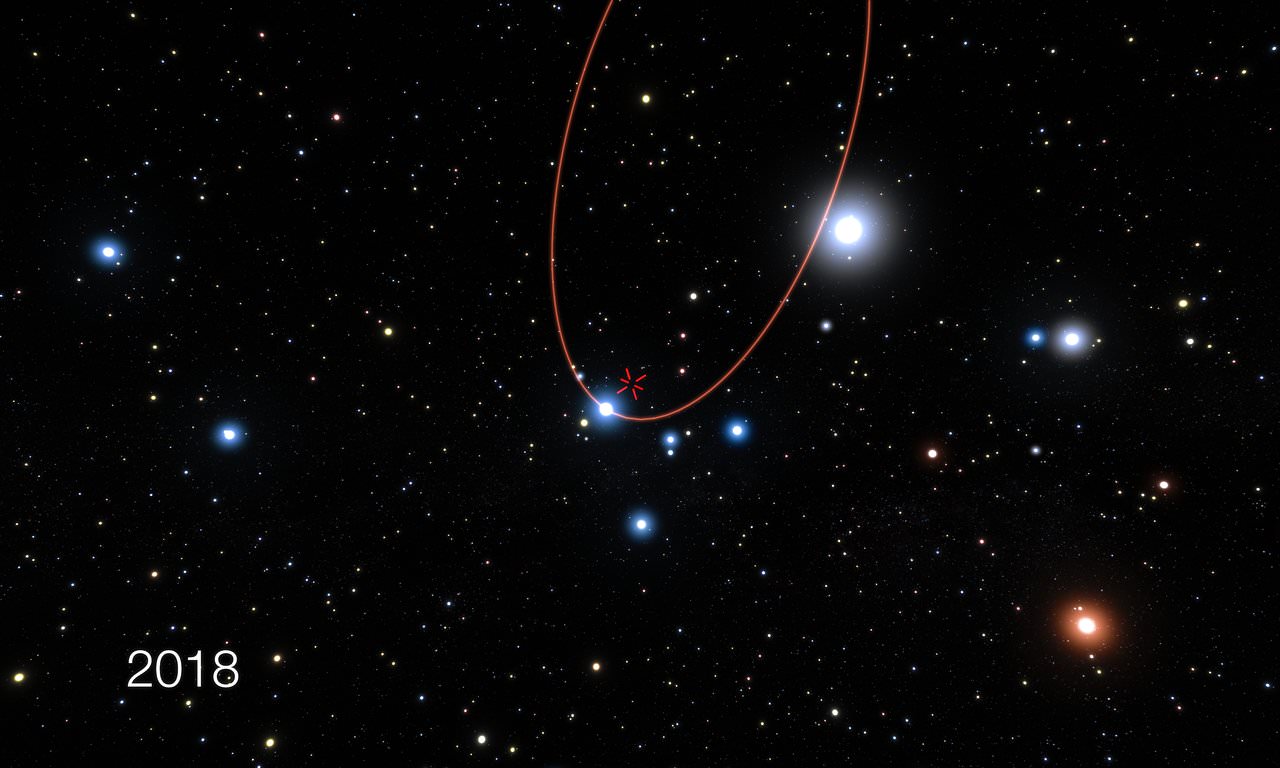
Since it was first discovered in 1974, astronomers have been dying to get a better look at the Supermassive Black Hole (SBH) at the center of our galaxy. Known as Sagittarius A*, scientists have only been able to gauge the position and mass of this SBH by measuring the effect it has on the stars that orbit it. But so far, more detailed observations have eluded them, thanks in part to all the gas and dust that obscures it.
Luckily, the European Southern Observatory (ESO) recently began work with the GRAVITY interferometer, the latest component in their Very Large Telescope (VLT). Using this instrument, which combines near-infrared imaging, adaptive-optics, and vastly improved resolution and accuracy, they have managed to capture images of the stars orbiting Sagittarius A*. And what they have observed was quite fascinating.
One of the primary purposes of GRAVITY is to study the gravitational field around Sagittarius A* in order to make precise measurements of the stars that orbit it. In so doing, the GRAVITY team – which consists of astronomers from the ESO, the Max Planck Institute, and multiple European research institutes – will be able to test Einstein’s theory of General Relativity like never before.
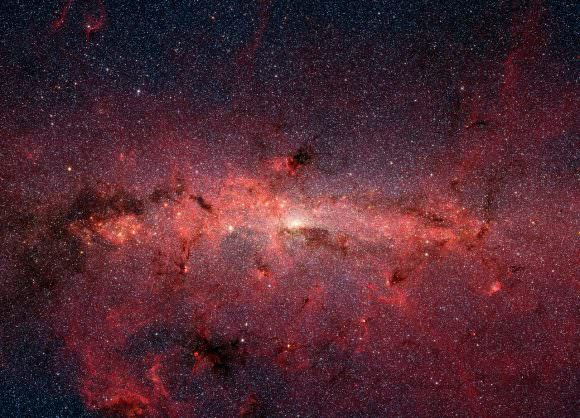
In what was the first observation conducted using the new instrument, the GRAVITY team used its powerful interferometric imaging capabilities to study S2, a faint star which orbits Sagittarius A* with a period of only 16 years. This test demonstrated the effectiveness of the GRAVITY instrument – which is 15 times more sensitive than the individual 8.2-metre Unit Telescopes the VLT currently relies on.
This was an historic accomplishment, as a clear view of the center of our galaxy is something that has eluded astronomers in the past. As GRAVITY’s lead scientist, Frank Eisenhauer – from the Max Planck Institute for Extraterrestrial Physics in Garching, Germany – explained to Universe Today via email:
“First, the Galactic Center is hidden behind a huge amount of interstellar dust, and it is practically invisible at optical wavelengths. The stars are only observable in the infrared, so we first had to develop the necessary technology and instruments for that. Second, there are so many stars concentrated in the Galactic Center that a normal telescope is not sharp enough to resolve them. It was only in the late 1990′ and in the beginning of this century when we learned to sharpen the images with the help of speckle interferometry and adaptive optics to see the stars and observe their dance around the central black hole.”
But more than that, the observation of S2 was very well timed. In 2018, the star will be at the closest point in its orbit to the Sagittarius A* – just 17 light-hours from it. As you can see from the video below, it is at this point that S2 will be moving much faster than at any other point in its orbit (the orbit of S2 is highlighted in red and the position of the central black hole is marked with a red cross).
When it makes its closest approach, S2 will accelerate to speeds of almost 30 million km per hour, which is 2.5% the speed of light. Another opportunity to view this star reach such high speeds will not come again for another 16 years – in 2034. And having shown just how sensitive the instrument is already, the GRAVITY team expects to be able make very precise measurements of the star’s position.
In fact, they anticipate that the level of accuracy will be comparable to that of measuring the positions of objects on the surface of the Moon, right down to the centimeter-scale. As such, they will be able to determine whether the motion of the star as it orbits the black hole are consistent with Einstein’s theories of general relativity.
“[I]t is not the speed itself to cause the general relativistic effects,” explained Eisenhauer, “but the strong gravitation around the black hole. But the very high orbital speed is a direct consequence and measure of the gravitation, so we refer to it in the press release because the comparison with the speed of light and the ISS illustrates so nicely the extreme conditions.
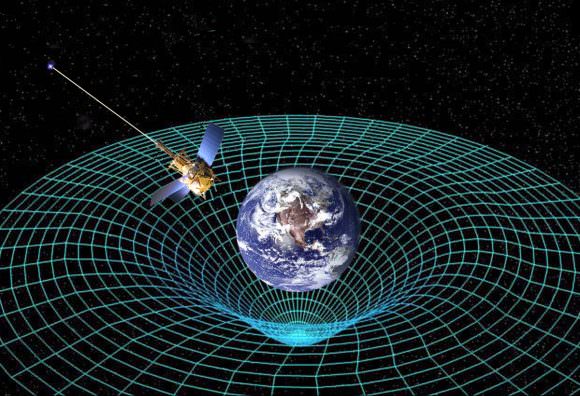
As recent simulations of the expansion of galaxies in the Universe have shown, Einstein’s theories are still holding up after many decades. However, these tests will offer hard evidence, obtained through direct observation. A star traveling at a portion of the speed of light around a supermassive black hole at the center of our galaxy will certainly prove to be a fitting test.
And Eisenhauer and his colleagues expect to see some very interesting things. “We hope to see a “kick” in the orbit.” he said. “The general relativistic effects increase very strongly when you approach the black hole, and when the star swings by, these effects will slightly change the direction of the
orbit.”
While those of us here at Earth will not be able to “star gaze” on this occasion and see R2 whipping past Sagittarius A*, we will still be privy to all the results. And then, we just might see if Einstein really was correct when he proposed what is still the predominant theory of gravitation in physics, over a century later.
Further Reading: eso.org

